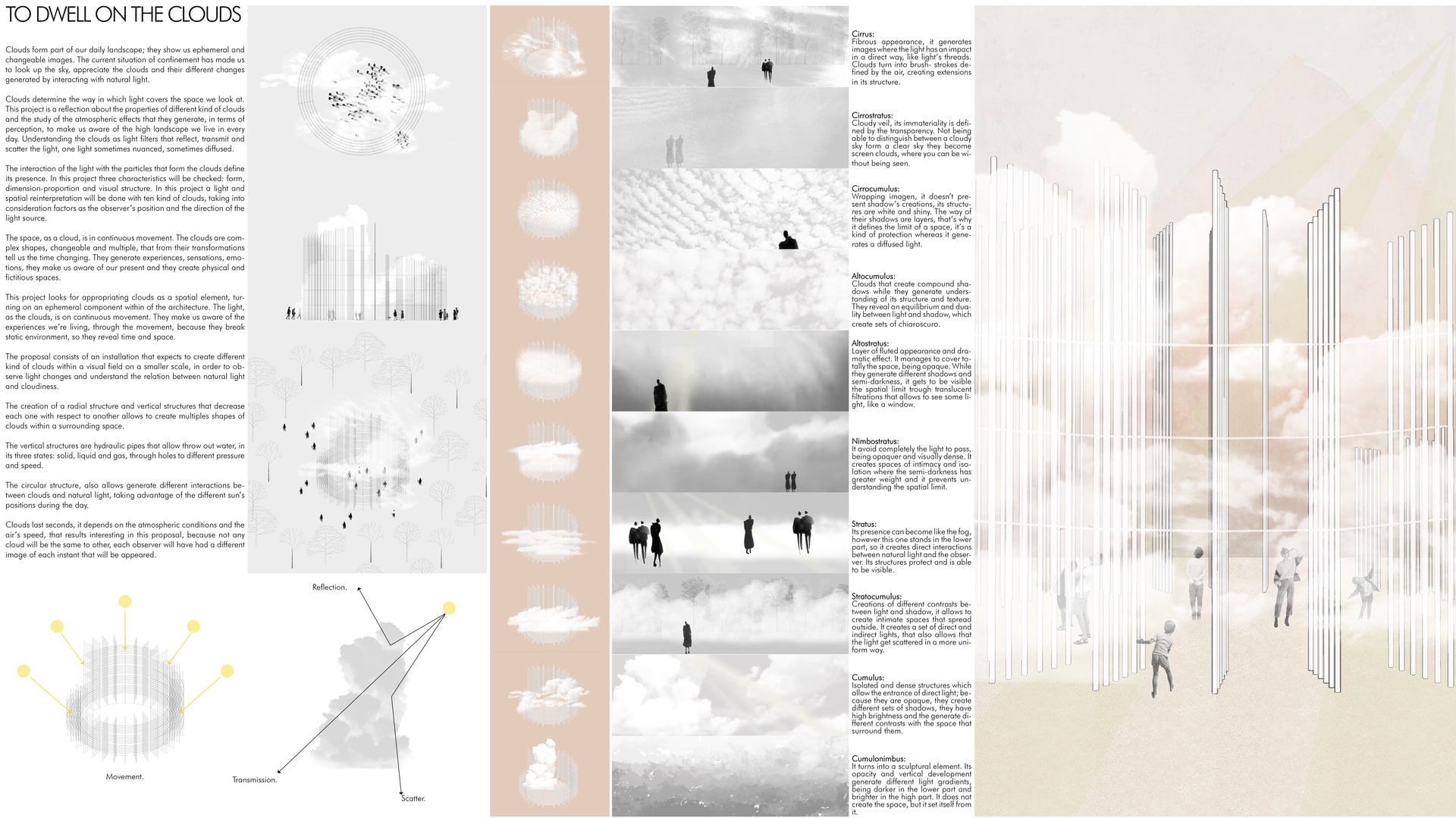Project Description
Clouds form part of our daily landscape; they show us ephemeral and changeable images. The current situation of confinement has made us to look up the sky, appreciate the clouds and their different changes generated by interacting with natural light. Clouds determine the way in which light covers the space we look at. This project is a reflection about the properties of different kind of clouds and the study of the atmospheric effects that they generate, in terms of perception, to make us aware of the high landscape we live in every day. Understanding the clouds as light filters that reflect, transmit and scatter the light, one light sometimes nuanced, sometimes diffused. The interaction of the light with the particles that form the clouds define its presence. In this project three characteristics will be checked: form, dimension-proportion and visual structure. In this project a light and spatial reinterpretation will be done with ten kind of clouds, taking into consideration factors as the observer’s position and the direction of the light source. The space, as a cloud, is in continuous movement. The clouds are complex shapes, changeable and multiple, that from their transformations tell us the time changing. They generate experiences, sensations, emotions, they make us aware of our present and they create physical and fictitious spaces. This project looks for appropriating clouds as a spatial element, turning on an ephemeral component within of the architecture. The light, as the clouds, is on continuous movement. They make us aware of the experiences we’re living, through the movement, because they break static environment, so they reveal time and space. The proposal consists of an installation that expects to create different kind of clouds within a visual field on a smaller scale, in order to observe light changes and understand the relation between natural light and cloudiness. The creation of a radial structure and vertical structures that decrease each one with respect to another allows to create multiples shapes of clouds within a surrounding space. The vertical structures are hydraulic pipes that allow throw out water, in its three states: solid, liquid and gas, through holes to different pressure and speed. The circular structure, also allows generate different interactions between clouds and natural light, taking advantage of the different sun’s positions during the day. Clouds last seconds, it depends on the atmospheric conditions and the air’s speed, that results interesting in this proposal, because not any cloud will be the same to other, each observer will have had a different image of each instant that will be appeared. -Types of clouds and its light reinterpretation: Cirrus: fibrous appearance, it generates images where the light has an impact in a direct way, like light’s threads. Clouds turn into brush- strokes defined by the air, creating extensions in its structure. Cirrostratus: cloudy veil, its immateriality is defined by the transparency. Not being able to distinguish between a cloudy sky form a clear sky they become screen clouds, where you can be without being seen. Cirrocumulus: wrapping imagen, it doesn’t present shadow’s creations, its structures are white and shiny. The way of their shadows are layers, that’s why it defines the limit of a space, it’s a kind of protection whereas it generates a diffused light. Altocumulus: Clouds that create compound shadows while they generate understanding of its structure and texture. They reveal an equilibrium and duality between light and shadow, which create sets of chiaroscuro. Altostratus: Layer of fluted appearance and dramatic effect. It manages to cover totally the space, being opaque. While they generate different shadows and semi-darkness, it gets to be visible the spatial limit trough translucent filtrations that allows to see some light, like a window. Nimbostratus: It avoid completely the light to pass, being opaquer and visually dense. It creates spaces of intimacy and isolation where the semi-darkness has greater weight and it prevents understanding the spatial limit. Stratus: Its presence can become like the fog, however this one stands in the lower part, so it creates direct interactions between natural light and the observer. Its structures protect and is able to be visible. Stratocumulus: Creations of different contrasts between light and shadow, it allows to create intimate spaces that spread outside. It creates a set of direct and indirect lights, that also allows that the light get scattered in a more uniform way. Cumulus: Isolated and dense structures which allow the entrance of direct light; because they are opaque, they create different sets of shadows, they have high brightness and the generate different contrasts with the space that surround them. Cumulonimbus: It turns into a sculptural element. Its opacity and vertical development generate different light gradients, being darker in the lower part and brighter in the high part. It does not create the space, but it set itself from it.
